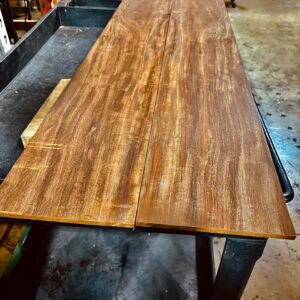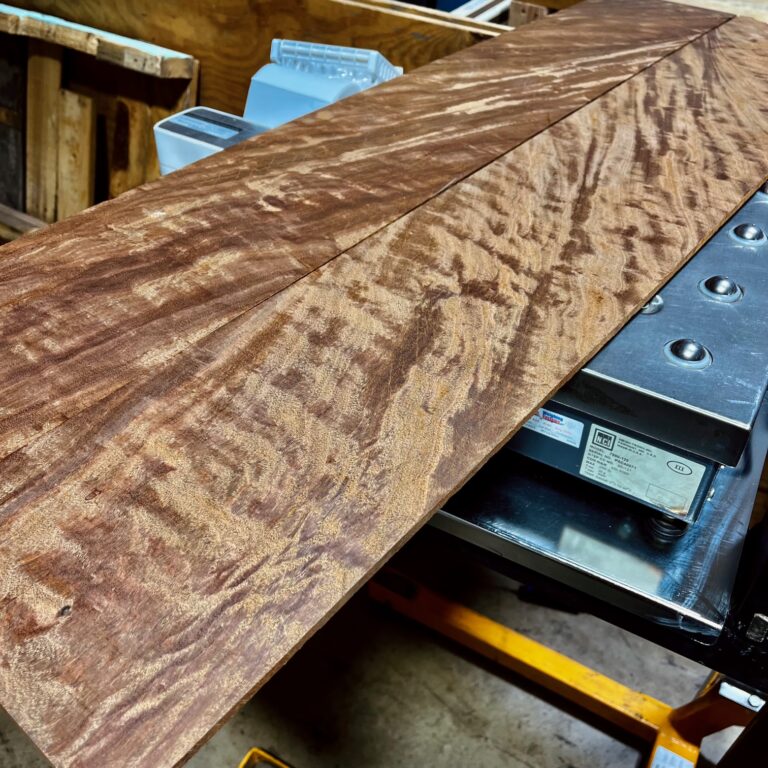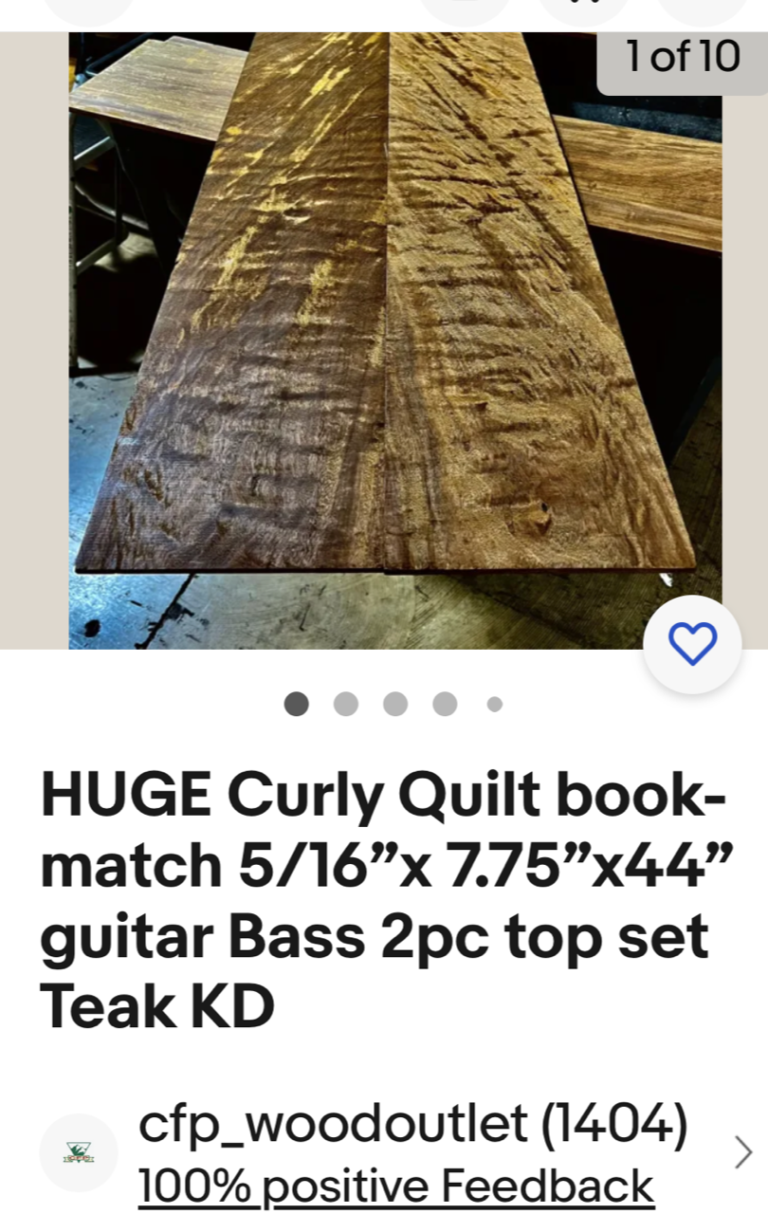Figured Iroko Wood: Dense Hardwood Timber
Iroko or African Teak is among the vast array of exotic timber options available to woodworkers. However, among North American hardwood lumber stores, it’s still somewhat uncommon
Iroko wood is remarkable for both its unique properties and diverse applications. In this article, we delve into the uses & characteristics of Iroko wood, exploring why it has captured the attention of woodworking enthusiasts worldwide.
Understanding Iroko Wood
Iroko wood, scientifically known as Milicia excelsa, hails from the west coast of tropical Africa. This majestic hardwood species has gained significant popularity due to its striking resemblance to teak wood in both appearance and performance.
Often referred to as African Teak, Iroko exhibits a range of golden to medium-brown hues, complemented by dark grain patterns that add depth, character and chatoyance to any woodworking project.
One of the most intriguing features of Iroko wood is its exceptional durability. It possesses remarkable resistance to decay, rot, and insect attacks, making it an excellent choice for both indoor and outdoor applications. This natural resistance is due to the presence of certain oils and extractives that enhance Iroko’s ability to withstand the test of time, making it a reliable and long-lasting material.

Properties of Iroko Wood
Let’s dive deeper into the properties that make Iroko wood a preferred choice for woodworkers and craftsmen:
-
Density and Strength: Iroko wood boasts impressive density and strength properties, making it highly resilient and durable. Its robust nature enables it to withstand heavy usage, making it suitable for furniture, flooring, decking, and even boat building.
-
Stability: Despite its density, Iroko wood exhibits good stability, reducing the risk of warping or twisting over time. This makes it ideal for applications where dimensional stability is crucial, such as doors, window frames, and outdoor structures.
-
Workability: Iroko wood is relatively easy to work with, thanks to its moderate to coarse texture and straight grain. It responds well to hand and machine tools, allowing woodworkers to achieve precise cuts, carvings, and joinery. However, it is important to note that due to its density, some tools may dull faster when working with Iroko.
-
Finishing: Iroko wood takes finishes exceptionally well, showcasing its natural beauty. It can be smoothly sanded to achieve a lustrous surface, and various finishes, such as oils, varnishes, or lacquers, can be applied to enhance its appearance and protect it from environmental factors.
Applications of Iroko Wood
The versatility of Iroko wood lends itself to a wide range of applications across different domains. Here are some popular uses of this remarkable timber:
-
Outdoor Projects: Iroko wood’s resistance to decay, rot, and insect attacks makes it a preferred choice for various outdoor projects. From decks and pergolas to garden furniture and exterior cladding, Iroko wood withstands the elements while exuding elegance and warmth.
-
Furniture: Iroko wood’s beautiful appearance, durability, and workability make it an excellent option for crafting furniture pieces. Its rich golden tones and distinct grain patterns add a touch of sophistication to tables, chairs, cabinets, and other bespoke creations.
-
Flooring: With its high density and natural resistance to wear, Iroko wood flooring is a popular choice for both residential and commercial spaces. Its warm hues bring a sense of richness to any room while providing a durable and long-lasting surface.
-
Architectural Woodwork: Iroko wood finds its place in architectural applications such as doors, window frames, and moldings. Its stability and resistance to warping make it an ideal choice for such projects, ensuring longevity and beauty.
-
Marine Applications: Due to its resistance to water, Iroko wood has become a favored material in boat building and marine applications. From decks and hulls to cabinetry and railings, it can withstand the harsh marine environment while lending an elegant touch to vessels.
Caring for Iroko Wood
To ensure the longevity and beauty of your Iroko wood creations, proper care and maintenance are essential. Here are some tips to keep in mind:
-
Regular Cleaning: Dust your Iroko wood furniture or surfaces regularly using a soft cloth or vacuum cleaner with a brush attachment to prevent the buildup of dirt and debris.
-
Avoid Moisture: While Iroko wood is naturally resistant to water, excessive moisture can still affect its appearance and stability. Wipe up spills promptly and use coasters or placemats to protect surfaces from heat and moisture.
-
Appropriate Finishing: Apply a protective finish, such as oil or varnish, to enhance the natural beauty of Iroko wood and shield it from environmental factors. Follow the manufacturer’s instructions for application and reapplication as needed.
-
Avoid Direct Sunlight: Prolonged exposure to direct sunlight can cause Iroko wood to fade over time. Consider using curtains or blinds to minimize exposure and preserve its original color.
-
Periodic Maintenance: Inspect your Iroko wood furniture or structures periodically for any signs of wear, such as scratches or dents. If necessary, sand and refinish the affected areas to restore their appearance.
Custom Millwork with Iroko Wood
With its remarkable properties, stunning aesthetics, and versatile applications, Iroko wood stands as a prized timber in the world of woodworking. Whether you’re crafting furniture, building outdoor structures, or adding an elegant touch to marine projects, Iroko wood is sure to leave a lasting impression. Embrace the splendor of this African treasure and bring your woodworking creations to life with the timeless beauty of Iroko wood.
Iroko Teak for Sale
Commercial Forest Products sells Iroko lumber worldwide at its online lumber store CFP_woodoutlet.


